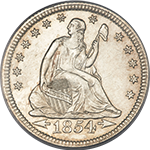The Seated Liberty quarter, like other denominations in the series, is a silver coin consisting of 90% silver. While the U.S. Mint produced these quarters from 1838 to 1891, the first coin in the series was actually a Seated Liberty dollar, first released in 1836. The Seated Liberty was the first series designed by famous engraver and medalist Christian Gobrecht.
Gobrecht was an exceptionally talented engraver and was even endorsed by President Monroe. However, as the U.S. Mint suffered from quite some nepotism back in the early years of the 19th century, Gobrecht, who was lacking in influence and power, was passed over for the position of assistant engraver to Chief Engraver Robert Pattinson. William Kneass, an engraver whose studio was a gathering place for prominent Philadelphians, was given the job instead. Yet, when Kneass had a stroke, Gobrecht was hired for the position in 1835. He began working on updating the design of the Mint’s coinage right away, and his first task was creating a new dollar coin – the Seated Liberty. As the Mint wanted all silver coins to have the same design, Gobrecht also developed the other denominations in the series.

The original design of the obverse side shows Lady Liberty seated upon a rock. The reverse side features an eagle clutching a bundle of arrows and an olive branch. This issue is called “No Motto”, as it does not yet bear the motto IN GOD WE TRUST. It is interesting to note that some subtle design features indicate changes in the silver content of the coin. The weight of the Seated Liberty quarter was adjusted over the years of production due to the fluctuating price of silver. The metal’s value exceeded the face value of the quarter by 1851, which led to a coin shortage as speculators melted down currency. Subsequently, the silver weight in Seated Liberty coins was reduced. In 1853, Arrows were added to either side of the date on the obverse, while rays were included around the eagle on the reverse to indicate the decreased silver amount. Due to increase in cost and time, the rays were removed in 1854 while the arrows were abandoned in 1856. After the weight increased in 1873, arrows were added to the date again. Moreover, the motto IN GOD WE TRUST was added in 1866.
The Seated Liberty quarter coin contains 90% silver and 10% copper.
Seated Liberty Quarter Facts
| Diameter: | 26.73 g |
| Weight until 1853: | 6.68 g |
| Weight 1853 to 1873: | 6.22 g |
| Weight 1873 to 1891: | 6.25 g |
Seated Liberty quarter coins were minted in Philadelphia, New Orleans, San Francisco, and Carson City. The lack of any mintmark means that the coin was struck in Philadelphia, while O, S, and CC stand for New Orleans, San Francisco, and Carson City, respectively. The mintmark is located below the eagle on the reverse side of the coin. After over 50 years, the Seated Liberty coinage was retired in 1892.
These silver coins can be worth1 far more than their face value today due to their added numismatic value. This is especially true for issues or varieties that had very small mintages and/or are in excellent condition. For example, No Drapery Seated Liberty quarters (only minted from 1838 to 1840) can fetch almost hundred thousand dollars. Yet, a No Motto coin from 1840 may be worth less than $40. Yet, even that is considerably more than the few dollars that the same amount of silver is worth today.
Given the range of values for several conditions and mintages of Seated Liberty quarters, this series may give collectors with varying budgets a chance to complete sets. This variety, in addition to the historical significance of the coinage, is one of the reasons why Seated Liberty silver coins are popular among both collectors and investors.

